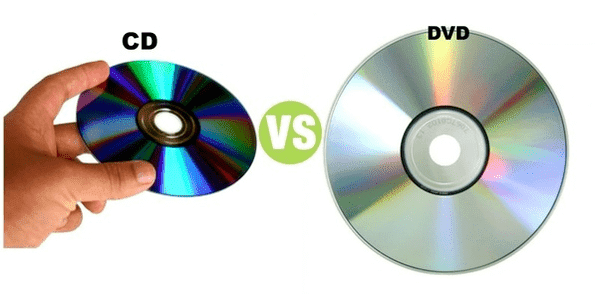Difference between CD and DVD
Compact Disk (CD) and Digital Versatile Disc (DVD) are two different versions of optical discs widely used for storing media. The major difference between both is their size and usage. DVD is capable of storing more data than CD, and due to this reason, both sides of a DVD are covered with polycarbonate substrate. While in the case of CD, this substrate is only present on one side of the disc.
Working on both CD and DVD is based on optical technology, using the light to retrieve the information stored in the disk. To read the information, transform it into the pieces and then write the material to show it to the user, the light becomes focused on the disk. Below is the big distinction between CD and DVD.

1. Capacity
As the name suggests, Compact Disc or CD has less storage capacity than DVD. It is an optical medium which was designed to replace old cassette tapes and to store the data digitally. A standard CD is manufactured to store around 700 MB of data. That means one can store a video of 60 minutes or audio of 80 minutes of good quality in a CD. Whereas, Digital Versatile Disc, i.e., DVD is a versatile optical medium designed to store more data than a CD. It can be used to store large files whose size may vary from 4.7 GB to 17 GB. So, it is mainly used to store movies and videos. Because of enormous compatibility and large space availability, DVDs are used more than CDs.
2. Use
As the size of a DVD and a CD differs, they are used differently in the market. Before the introduction of the DVD, the CD has its great importance in the market of digital storage. It has many advantages over ancient cassettes and VHS tapes. It can be easily located to any point without rewinding or forwarding. Also, the quality of media stored is not affected by the number of times it has been played. Owing to all these reasons, it gained popularity for storing data and omitted the use of cassettes and VHS tapes. It was the stage when the software and computer programs were used to store in the CD.
CD doesn’t have a much larger capacity. To overcome this, the DVD was designed in the same way with a much higher capacity of 4.7 GB. Nowadays, a DVD of 17 GB is also available in the market. Storage of larger files, computer programs, software, and videos turned towards the use of DVD owing to its higher storage space. However, the cost of the DVD is higher than the CD and both works on the same principle. It is the reason why the DVD has not entirely replaced the CD. CDs are mainly used to store smaller files like music albums and others.
3. Playback
A standard DVD player can play both CD and DVD, but a CD player can only be used to play a CD. CD is widely used to store music albums and data with a small size. The cost of the CD is also lower than a DVD. Overall, both optical discs mainly differ because of the storage capacity.
There is also some manufacturing difference between the CD and the DVD. The metal layer, which is used for recording the data, is placed under the labeling side in the CD while it is in the center in the case of the DVD. Moreover, the spacing between layers and pits is also different in both CD and DVD. The removal of the adhesive layer can put different impacts on both the optical discs. Hence, all the fundamental and significant differences between the CD and DVD are mentioned above.
There is no shortage of DVD burning software, but it can be too expensive for some people to use tools like Nero and Roxio. As always, there are plenty of free options to choose from, but you need to know that the right tool for the job is available.